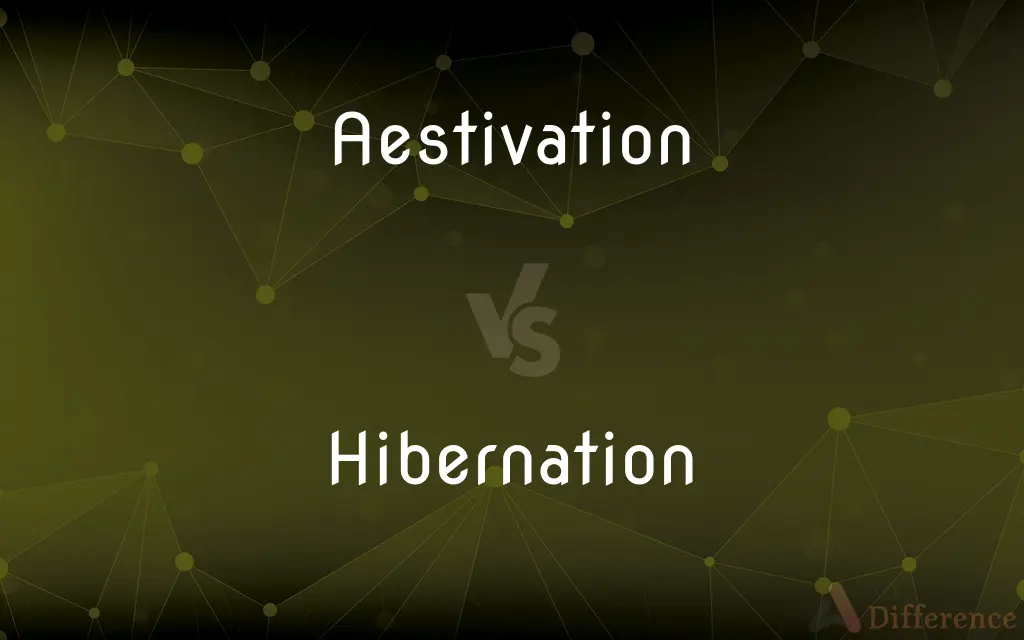Aestivation vs. Hibernation — What's the Difference?
By Maham Liaqat & Fiza Rafique — Updated on March 24, 2024
Aestivation is dormancy in summer to avoid heat and drought, while hibernation is winter dormancy to conserve energy.

Difference Between Aestivation and Hibernation
Table of Contents
ADVERTISEMENT
Key Differences
Aestivation and hibernation are both strategies used by animals to survive extreme environmental conditions, but they occur at opposite times of the year and in response to different climatic challenges. Aestivation helps animals escape the scorching temperatures and arid conditions of summer, particularly in hot, dry climates. In contrast, hibernation allows animals to conserve energy during the cold winter months when food is scarce, helping them to survive periods of low temperatures and food shortage.
The physiological processes involved in aestivation and hibernation vary but share some similarities, such as reduced metabolic rate and decreased body temperature. During aestivation, animals slow down their metabolism to reduce water loss and conserve energy in the heat. Meanwhile, hibernating animals undergo physiological changes that significantly lower their metabolic rate, body temperature, and energy needs, allowing them to live off their stored fat.
Aestivation is commonly observed in invertebrates like snails and insects, and some amphibians and reptiles, which may burrow into the ground or find cool, moist shelters. On the other hand, hibernation is more associated with mammals, including bears, bats, and rodents, although some birds and reptiles also exhibit similar behaviors.
The duration of aestivation and hibernation can vary significantly among species, from a few days or weeks to several months, depending on environmental conditions, species' adaptations, and the severity of the climate. Aestivation typically lasts for the hottest and driest months, whereas hibernation can span the entire winter season.
Both aestivation and hibernation have profound implications for the survival and reproductive cycles of animals. These periods of dormancy not only help animals conserve energy during times of environmental stress but also affect their breeding cycles, migration patterns, and ecosystem roles. For instance, the timing of emergence from hibernation can influence mating seasons and the availability of food resources for newborns.
ADVERTISEMENT
Comparison Chart
Purpose
Avoid heat and drought in summer
Conserve energy during winter scarcity
Occurrence
Summer
Winter
Common in
Invertebrates, some amphibians and reptiles
Mammals, some birds and reptiles
Metabolic Changes
Reduced metabolic rate to conserve water and energy
Significantly lowered metabolic rate and body temperature
Duration
Can last from days to months, depending on conditions
Often spans the entire winter season
Compare with Definitions
Aestivation
A dormancy period in response to hot and dry conditions.
The desert tortoise aestivates to escape the harsh summer.
Hibernation
A dormancy period to conserve energy during winter.
Bears hibernate to survive the winter without eating.
Aestivation
Helps animals survive extreme summer temperatures.
Aestivating animals become inactive to reduce water loss.
Hibernation
Allows survival through food scarcity and cold weather.
Hibernation enables animals to live off their fat reserves.
Aestivation
Primarily seen in invertebrates and some reptiles and amphibians.
Some frogs aestivate buried in mud to stay cool.
Hibernation
Common among mammals and observed in some birds and reptiles.
The Arctic ground squirrel hibernates to escape the cold.
Aestivation
Involves metabolic slowdown to conserve moisture and energy.
During aestivation, snails seal themselves in their shells.
Hibernation
Influences migration, breeding, and ecosystem dynamics.
The timing of hibernation affects when animals reproduce and emerge in spring.
Aestivation
Affects seasonal behavior and reproductive cycles.
Aestivation patterns can influence when animals breed.
Hibernation
Characterized by a significant drop in metabolic rate and body temperature.
Hibernating bats enter a state of torpor.
Aestivation
Aestivation (Latin: aestas (summer); also spelled estivation in American English) is a state of animal dormancy, similar to hibernation, although taking place in the summer rather than the winter. Aestivation is characterized by inactivity and a lowered metabolic rate, that is entered in response to high temperatures and arid conditions.
Hibernation
Hibernation is a state of minimal activity and metabolic depression. Hibernation is a seasonal heterothermy characterized by low body-temperature, slow breathing and heart-rate, and low metabolic rate.
Aestivation
Variant of estivation.
Hibernation
To be in a dormant or torpid state during a cold period, especially during the winter.
Aestivation
(biology) A state of inactivity and metabolic depression during summer: the summer version of hibernation.
Hibernation
To be in an inactive or dormant state or period
"In Lawrenceville people hibernated and life passed them by" (Jacqueline Susann).
Aestivation
(botany) The arrangement (vernation) of the parts of a flower inside a bud; prefloration.
Hibernation
A state of minimum power consumption, inactivity and metabolic depression in some animals during winter.
Aestivation
(obsolete) The spending or passing of a summer.
Hibernation
A hypothetical state of minimum power consumption, inactivity and metabolic depression in humans during long space flights.
Aestivation
The state of torpidity induced by the heat and dryness of summer, as in certain snails; - opposed to hibernation.
Hibernation
(computing) A standby state which conserves power by writing the contents of the memory to disk and completely power off the computer, in order that one will resume the session from the disk.
Aestivation
The arrangement of the petals in a flower bud, as to folding, overlapping, etc.; prefloration.
Hibernation
The act or state of hibernating.
Aestivation
(zoology) cessation or slowing of activity during the summer; especially slowing of metabolism in some animals during a hot or dry period
Hibernation
The torpid or resting state in which some animals pass the winter
Aestivation
(botany) the arrangement of sepals and petals in a flower bud before it opens
Hibernation
Cessation from or slowing of activity during the winter; especially slowing of metabolism in some animals
Hibernation
The act of retiring into inactivity;
He emerged from his hibernation to make his first appearance in several years
Common Curiosities
Do animals eat during aestivation or hibernation?
Generally, animals do not eat during these periods and rely on stored energy.
What triggers aestivation and hibernation in animals?
Aestivation is triggered by high temperatures and drought, while hibernation is triggered by cold temperatures and food scarcity.
Is hibernation the same as sleeping?
No, hibernation involves profound physiological changes, whereas sleep is a regular, daily activity.
Can any animal aestivate or hibernate?
No, only specific species have adapted to survive by aestivating or hibernating.
Can hibernation or aestivation affect an animal's reproductive cycle?
Yes, these dormancy periods can influence breeding times and reproductive success.
How do animals know when to end their dormancy?
Environmental cues like temperature changes signal animals to end aestivation or hibernation.
Can an animal be awakened from hibernation or aestivation?
While possible, it can be stressful and harmful to the animal due to the energy shift required.
Is hibernation considered a form of sleep?
While similar to sleep, hibernation is a deeper, longer-term form of dormancy.
How does hibernation affect an animal's lifespan?
Hibernation can extend an animal's lifespan by reducing metabolic stress and energy demands.
Do animals lose weight during hibernation?
Yes, animals live off their fat reserves and lose weight during hibernation.
Can aestivation occur in any climate?
Aestivation mainly occurs in hot and dry climates where it's necessary to survive extreme conditions.
How do animals prepare for hibernation or aestivation?
They accumulate energy reserves and find a safe place to reduce exposure to harsh conditions.
Are there any risks associated with aestivation or hibernation?
Yes, risks include vulnerability to predators and the possibility of not waking up if energy reserves are depleted.
What happens to an animal's body temperature during hibernation?
It significantly decreases to conserve energy and match the ambient temperature.
What is the difference between torpor and hibernation?
Torpor is a short-term state of decreased physiological activity, while hibernation is a long-term seasonal dormancy.
Share Your Discovery

Previous Comparison
Cause vs. Reason
Next Comparison
Misspelled vs. MisspeltAuthor Spotlight
Written by
Maham LiaqatCo-written by
Fiza RafiqueFiza Rafique is a skilled content writer at AskDifference.com, where she meticulously refines and enhances written pieces. Drawing from her vast editorial expertise, Fiza ensures clarity, accuracy, and precision in every article. Passionate about language, she continually seeks to elevate the quality of content for readers worldwide.














































